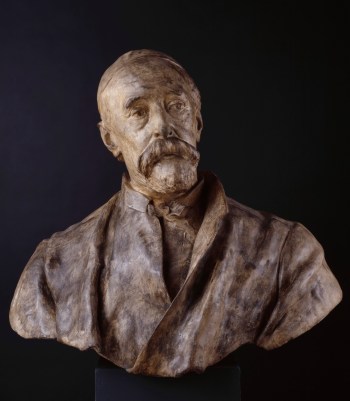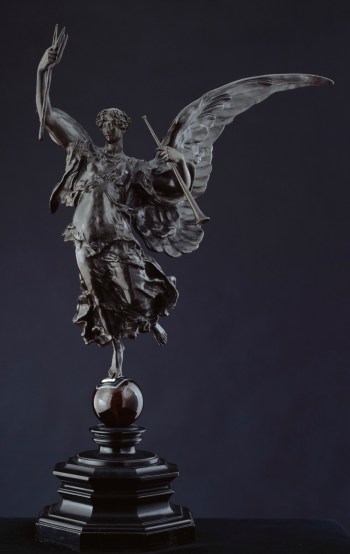Sir Alfred Gilbert RA (1854 - 1934)
RA Collection: People and Organisations
Sir Alfred Gilbert was born in London but schooled at Aldenham, Hertfordshire, where his father taught music. Gilbert failed to obtain a scholarship to become a surgeon, and instead pursued his interest in sculpture, studying first at Heatherley’s School and Royal Academy Schools (where he quickly became disillusioned with the training of sculptors). More valuable experience was obtained during this period from working part-time in the studios of established sculptors such as Edgar Boehm.
In 1875, Gilbert moved to Paris to study at the École des Beaux-Arts – Boehm had suggested this, but another reason for doing so was to elope with his cousin Alice Jane Gilbert, who was expecting their child. In 1878 Gilbert moved to Italy, where he began to carve and cast, returning to England in 1884.
The years between 1885 and 1898 were Gilbert’s most productive – he made works including the jubilee memorial to Queen Victoria in Winchester, taught himself the art of the goldsmith. He became the first artist in Britain to cast in aluminium, using it to make the statue of Eros which crowns his Shaftesbury Memorial in Piccadilly Circus, London. Gilbert was elected as a Royal Academician in 1892 and demand for his work was increased by his status as the favourite sculptor of the royal family (Gilbert was a friend of Queen Victoria’s daughter Princess Louise).
Gilbert’s popularity arguably triggered his downfall as the artist was unable to turn down commissions but he found them burdensome and regularly took many years to fulfil them. Eventually, clients tired of his failure to deliver works they had already paid for and accused him of cheating them. In 1901 Gilbert declared bankruptcy, sold off the contents of his house and studio, and moved his family to Bruges in Belgium where he started an unsuccessful art school. He still returned to London regularly and continued as professor of sculpture at the RA (1901–3 and 1905) but in 1908 accusations of dishonourable behaviour against Gilbert forced his resignation as an Academician.
After a long absence on the continent, Gilbert eventually returned to England in 1926. He was forgiven by George V who provided him with studios in royal palaces and this triggered a revival of Gilbert’s fortunes. He received a prestigious commission for a monument to Queen Alexandra which was unveiled in 1932, the same year he was reinstated as an Academician and knighted.
Profile
Born: 12 August 1854 in London, England, United Kingdom
Died: 4 November 1934
Nationality: British
RA Schools student from 17 January 1874
Elected ARA: 7 January 1887
Elected RA: 8 December 1892
Elected Senior RA: 31 May 1932
Professor of Sculpture: 1900 - 1904
Resigned: 25 Nov 1908
Rejoined: 31 May 1932
Gender: Male
Preferred media: Sculpture
Works by Sir Alfred Gilbert in the RA Collection
7 results
-
![Sir Alfred Gilbert RA, Bust of Lionel Smythe, R.A.]()
Sir Alfred Gilbert RA
Bust of Lionel Smythe, R.A., 1898
Bronze
-
![Sir Alfred Gilbert RA, Bust of George Frederic Watts, R.A.]()
Sir Alfred Gilbert RA
Bust of George Frederic Watts, R.A., 1889
Plaster
-
![Sir Alfred Gilbert RA, Sketch model for a symbolic figure on the Queen Victoria Monument, Winchester]()
Sir Alfred Gilbert RA
Sketch model for a symbolic figure on the Queen Victoria Monument, Winchester, ca. 1887
Bronze
-
![Sir Alfred Gilbert RA, Bust of George Frederic Watts, R.A.]()
Sir Alfred Gilbert RA
Bust of George Frederic Watts, R.A., 1889
Bronze
-
![Sir Alfred Gilbert RA, Victory]()
Sir Alfred Gilbert RA
Victory, ca. 1887
Bronze
-
![Sir Alfred Gilbert RA, Model for Eros]()
Sir Alfred Gilbert RA
Model for Eros, 1891
Bronze, cast in 1925-26 after an original of 1891.
-
![Sir Alfred Gilbert RA, Bust of Lionel Percy Smythe R.A.]()
Sir Alfred Gilbert RA
Bust of Lionel Percy Smythe R.A., 1898
Plaster cast
Works associated with Sir Alfred Gilbert in the RA Collection
2 results
Associated books
1 results
Associated archives
47 results
-
Alfred Gilbert: Sculptor and Goldsmith
1986
Item RAA/PRE/5/2/189
-
Correspondence concerning a memorial tablet for Sir Alfred Gilbert and the sale of various works
1934-38
Series SP/19
-
Newspaper obituaries for Alfred Gilbert, together with correspondence concerning his will and estate
1934
Series SP/18
-
Miscellaneous letters and papers relating to Alfred Gilbert
1926-1934
Series SP/17








